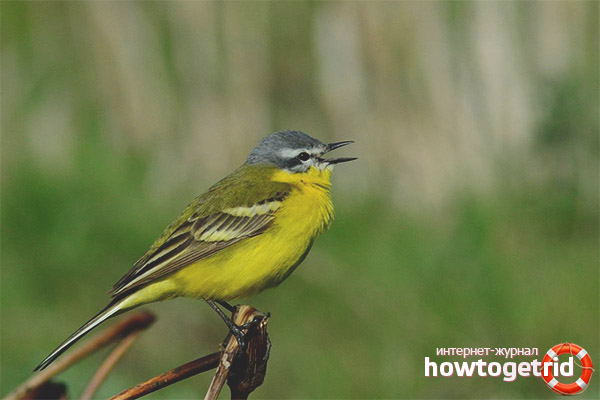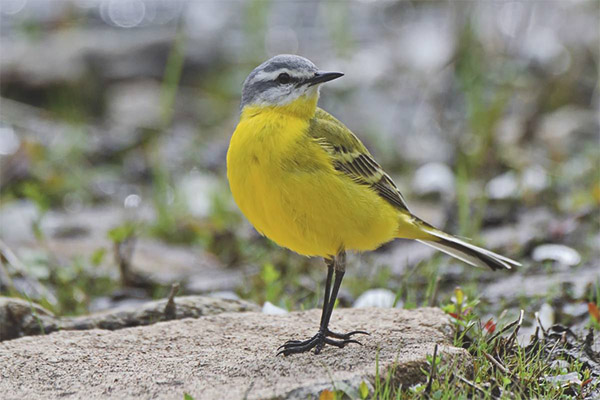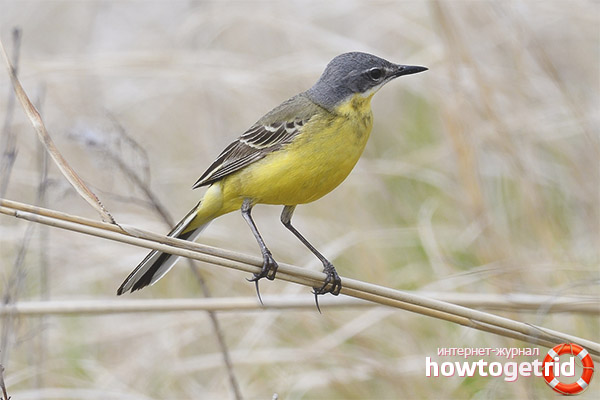The content of the article
The yellow wagtail is ranked as the family of the wagtail, the weight of this small bird does not exceed 17 grams, and the body size of an adult individual reaches 17 centimeters. The wagtail has a rather long and thin tail, which characterizes all the representatives of this family. The bird acquired its name due to the peculiar tail shaking, which it periodically performs.
The lower part of the body of this little bird has a yellow color, and on the back it has a gray-olive plumage. On its wings, which have a dark brown color, white stripes are clearly distinguishable, and white stripes are also distinguished on the black tail of the wagtail.
On the head of an adult male there is a gray, sometimes black zone, which looks like a hat. The females of these birds also have similar formations on their heads, but unlike males, it has a brownish-gray tint and rather blurry outlines. The legs, like the beak of these birds, are painted black.Juveniles of yellow wagtails have plumage colored in brownish gray.
Habitats
By and large, the yellow wagtail is a migratory bird, only in a few southern regions it chooses a sedentary life. You can meet this bird in various lowlands, where forests are located or forest-steppe belts, and it is also attracted by swampy meadows or river valleys. Marshland with grass and rare shrubs is also suitable for it as a habitat.
But in the taiga, the wagtail is almost never encountered, except for the coast of forest rivers. This bird does not comply with the precise conditions of the settlement, it is capable of both a single form and group meetings.
The period of breeding offspring
The yellow wagtail rushes to the places of its nesting immediately after the snow melts and the first green appears. Here, much depends on the latitude, in the territory of the middle zone its appearance is expected in the second half of April, and in regions of Siberia it cannot be met before the beginning of May.
A prerequisite for the settlement of these birds is the close proximity to various water bodies. It can easily be flooded meadows of the coast of lakes and various rivers. Swampy plains with sparse shrubs also attract the attention of wagtails. The place for the nest must meet many requirements, so the birds take the time to select it, spending several days searching.
The male does not take part in incubation of the clutch and in the nest device, all this time it is located nearby on a convenient height, protecting the territory from enemy invasion. When the female sits on the clutch, the male provides her with food.
Nest these birds arrange right on the ground, finding a suitable recess, under the cover of a hummock, a lone bush or high grass. When there is a threat, which is most often the crows, as well as dogs and even people, the bird shows a rather restless behavior.The male takes off and tries to distract the attention of the uninvited guest, while the female retreats under the cover of grass at a distance of up to 20 meters, then takes off and, returning, joins the actions of the male. In the case of the frequent appearance of uninvited guests, she can easily leave the nest.
The wagtail nest is shaped like a shallow bowl; small twigs, various leaves, dry grass stems and root fragments serve as material for its construction. For laying the nest, these birds use hair mixed with wool. In the laying of the female there are about 5 eggs, which have a yellowish, sometimes greenish, shade with frequent splashes of gray, less often - brown.
The wagtail hatchs its laying for about 13 days, the chicks grow only two weeks. Both parents are engaged in raising the offspring, and they also take care of their offspring who have recently left the nest for some time, because at first the young wagtails cannot get their own food. In rare cases, they manage to feed two broods in one season.
Diet

Birds of this species are very similar in their behavior to white wagtails, and differ from them in that yellow wagtails search for food on the ground, while white wagtails do it in the air. In search of their prey, these birds flutter close to the ground and, descending, move rather deftly along it.
Having found its prey, the wagtail begins the pursuit only of her alone, without being distracted by the other temptations. Upon successful completion of the chase, the victim is immediately swallowed. This bird will never allow the chase "for two hares", apparently, it knows what this leads to. In the case when food in the nesting area is not enough, the yellow wagtail is ready to challenge its rights with its closest neighbors.
At the end of the summer, rested adults, together with the young, begin small migrations in the wetlands, and from the second decade of August to mid-October they set off on a seasonal flight.They prefer to winter in the southern regions of Asia or in Africa, and they can also go to the Malay Islands, some even to the coast of the Philippines.
Video: Yellow Wagtail (Motacilla flava)












To send